|
|
|
Sort Order |
|
|
|
Items / Page
|
|
|
|
|
|
|
| Srl | Item |
| 1 |
ID:
165997


|
|
|
|
|
| Summary/Abstract |
This study examines the effect of energy resources on the chances for militarized conflict, water related conflict and cooperation events, and cooperative river treaties between pairs of states on shared international river basins. We examine trade-offs that riparian states can make between energy resources such as oil or natural gas and fresh water resources. Integrating upstream and downstream states’ geographical position in a river basin with energy resource information, we examine four related scenarios of states sharing rivers: (1) Joint energy where both upstream and downstream countries have energy resources, (2) Downstream energy where only the downstream state has energy resources, (3) Upstream energy where only an upstream country has energy resources, and (4) No energy. Theoretically, we argue that Downstream energy dyads are most likely to find cooperative solutions to conflicts over shared river resources because downstream states can offer oil and natural gas side payments to upstream states in exchange for greater water supplies. Empirical analyses of dyadic data in shared river basin dyads from 1945 to 2001 provide strong support for the theory. Riparian cooperation through river treaties and diplomacy is best achieved in Downstream energy dyads, where the downstream states have energy resources that can be traded for water resources with upstream states. Militarized conflict and water related conflict events are most likely in Joint energy dyads. Case illustrations from the Aral Sea and Ganges river basins are used to demonstrate the theoretical arguments.
|
|
|
|
|
|
|
|
|
|
|
|
|
|
|
|
| 2 |
ID:
165996
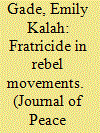

|
|
|
|
|
| Summary/Abstract |
Violent conflict among rebels is a common feature of civil wars and insurgencies. Yet, not all rebel groups are equally prone to such infighting. While previous research has focused on the systemic causes of violent conflict within rebel movements, this article explores the factors that affect the risk of conflict between pairs of rebel groups. We generate hypotheses concerning how differences in power, ideology, and state sponsors between rebel groups impact their propensity to clash and test them using data from the Syrian civil war. The data, drawn from hundreds of infighting claims made by rebel groups on social media, are used to construct a network of conflictual ties among 30 rebel groups. The relationship between the observed network structure and the independent variables is evaluated using network analysis metrics and methods including assortativity, community structure, simulation, and latent space modeling. We find strong evidence that ideologically distant groups have a higher propensity for infighting than ideologically proximate ones. We also find support for power asymmetry, meaning that pairs of groups of disparate size are at greater risk of infighting than pairs of equal strength. No support was found for the proposition that sharing state sponsors mitigates rebels’ propensity for infighting. Our results provide an important corrective to prevailing theory, which discounts the role of ideology in militant factional dynamics within fragmented conflicts.
|
|
|
|
|
|
|
|
|
|
|
|
|
|
|
|
| 3 |
ID:
165999
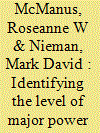

|
|
|
|
|
| Summary/Abstract |
Major powers signal support for protégés in order to reassure them and deter harm against them. Yet, it is not always clear how to identify who a major power’s protégés are or the degree of support signaled. Major powers have a variety of complementary signals to choose among, including alliances, arms transfers, joint military exercises, and others. It can be difficult to weigh the importance of individual signals, especially since different major powers do not deploy each signal in the same way. We address this challenge using a Bayesian latent measurement model, which provides a theoretically coherent means of identifying the overall level of support signaled by a major power for a protégé. Our approach yields a cross-sectional time-series dataset, providing a continuous measure of the degree of support signaled by major powers for all minor powers from 1950 to 2012. Our model also provides insights regarding which signals of support are most informative when sent by each major power. We find considerable variation among major powers regarding which of their signals are most meaningful, but in general alliances and military exercises tend to be among the most important signals. In further applications using our latent measure, we also assess under which conditions major powers are likely to increase their signals of support for protégés, as well as predict whether a major power will intervene in conflicts involving its protégés.
|
|
|
|
|
|
|
|
|
|
|
|
|
|
|
|
| 4 |
ID:
166003


|
|
|
|
|
| Summary/Abstract |
Despite their pernicious effect on intergroup conflict, collateral casualties are seen as inevitable and justified by many members of the groups involved, particularly those who endorse a right-wing ideology. Drawing on social psychological literature, we examined whether a perception of commonality between in-group and out-group can be beneficial for reducing tolerance to collateral causalities. We hypothesized that viewing the out-group as sharing commonalities with the in-group can reduce processes of out-group delegitimization, which are common among right-wingers in intractable conflicts, and may therefore serve to explain reduction in tolerance to collateral casualties. Three correlational studies were conducted among Jewish-Israelis in the context of the conflict with the Palestinians to test this. In Study 1, right-wing political ideology was associated with stronger support for enemy collateral casualties, and the effect was moderated by perceived intergroup commonality. While leftists were overall non-supportive of collateral casualties, rightists who perceived high intergroup commonality were less tolerant of collateral casualties than those low on intergroup commonality. In Study 2, conducted during violent escalation, we replicated these results while controlling for anger, fear, and hatred. In Study 3, we found that the effect was mediated by delegitimization of the out-group. These results extend the range of beneficial impact of intergroup commonality, and imply that it may be used as a tool to promote conflict resolution.
|
|
|
|
|
|
|
|
|
|
|
|
|
|
|
|
| 5 |
ID:
166000
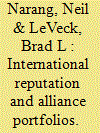

|
|
|
|
|
| Summary/Abstract |
Why do states ever form military alliances with unreliable partners? States sign offensive and defensive military alliances to increase their fighting capabilities in the event of war and as a signal to deter potential aggressors from initiating a crisis. Yet, signing an alliance with an unreliable partner is at odds with both of these rationales. This should be particularly concerning for peace scholars and policymakers, since the uncertainty generated by unreliable partners may increase system-wide conflict. This article provides an answer to this puzzle by arguing that states continue to form alliances with unreliable partners because they can adopt rational portfolio-diversification strategies. Drawing on well-developed models from portfolio theory, we present evidence that states design their overall alliance portfolios to minimize the risks posed by allies with a reputation for being unreliable. Specifically, we show that unreliable allies are more likely to be pooled into multilateral alliances that dilute risk rather than bilateral alliances, and that states allied with unreliable partners form a greater number of alliances to hedge against the added risk of default. Together, our results demonstrate why unreliable partners may not lead to increased conflict initiation, while also providing a novel explanation for previously unexplained variation in the structure of alliance portfolios. The article contributes to the literatures on international reputation and the rational design of international institutions by demonstrating how international reputation matters in subtle and often overlooked ways.
|
|
|
|
|
|
|
|
|
|
|
|
|
|
|
|
| 6 |
ID:
166005
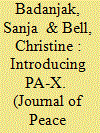

|
|
|
|
|
| Summary/Abstract |
This article introduces PA-X, a peace agreement database designed to improve understanding of negotiated pathways out of conflict. PA-X enables scholars, mediators, conflict parties and civil society actors to systematically compare how peace and transition processes formalize negotiated commitments in an attempt to move towards peace. PA-X provides an archive and comprehensive census of peace agreements using a broad definition to capture agreements at all phases of peace processes in both intrastate and interstate conflict, from 1990 to 2016. These comprise ceasefire, pre-negotiation, substantive (partial and comprehensive), and implementation agreements, disaggregated by country/entity, region, conflict type, agreement type and stage of agreement totalling over 1,500 agreements in more than 140 peace and transition processes. PA-X provides the full text of agreements, and qualitative and quantitative coding of 225 categories relating to politics, law, security, development and implementation. Data can be aggregated or merged with conflict datasets, effectively providing many datasets within one database. PA-X supports new comparative research on peace agreements, but also on peace processes – enabling tracing of how actors and issues change over time – to inform understandings of conflict termination. We illustrate PA-X applications by showing that an intricate peace process history correlates with reduced likelihood of conflict recurrence, and that cumulative provisions addressing elections see the quality of subsequent post-conflict elections improve.
|
|
|
|
|
|
|
|
|
|
|
|
|
|
|
|
| 7 |
ID:
166004


|
|
|
|
|
| Summary/Abstract |
The Historical Varieties of Democracy dataset (Historical V-Dem) contains about 260 indicators, both factual and evaluative, describing various aspects of political regimes and state institutions. The dataset covers 91 polities globally – including most large, sovereign states, as well as some semi-sovereign entities and large colonies – from 1789 to 1920 for many cases. The majority of the indicators come from the Varieties of Democracy dataset, which covers 1900 to the present – together these two datasets cover the bulk of ‘modern history’. Historical V-Dem also includes several new indicators, covering features that are pertinent for 19th-century polities. We describe the data, coding process, and different strategies employed in Historical V-Dem to cope with issues of reliability and validity and ensure intertemporal and cross-country comparability. To illustrate the potential uses of the dataset we describe patterns of democratization in the ‘long 19th century’. Finally, we investigate how interstate war relates to subsequent democratization.
|
|
|
|
|
|
|
|
|
|
|
|
|
|
|
|
| 8 |
ID:
165998


|
|
|
|
|
| Summary/Abstract |
This article conducts a meta-analysis of the effect of military expenditures on growth within a structured analytic framework. We extend the pioneering study of Aynur Alptekin and Paul Levine, by using a much larger sample of studies. Like them we confine our attention to studies that use the share of military expenditure in GDP, the military burden, as the independent variable, but unlike them we include not just those that use the military burden directly, what we call the core sample, but also those that use other functions of it, such as logarithms, differences, etc., which we call the remaining sample. We also consider an overall sample which pools all results. The t-statistic on the coefficient of military burden is used as the dependent variable. Our null hypothesis is that military expenditure has no significant effect on growth and we explain why this is plausible. The estimates are sensitive to the sample and type of data used, estimation method adopted, and the controls included. Overall, the results are consistent with the hypothesis of no effect: the average effect across all studies is close to zero. Certain study characteristics appear significant determinants of the effect of military expenditure on growth, but there does not appear to be a simple pattern and different characteristics were significant in the three samples. This might be a result of data mining to produce a significant result. However, there does not appear to be strong evidence of publication bias towards positive or negative results, perhaps because there is no strong a priori belief in the direction of the effect.
|
|
|
|
|
|
|
|
|
|
|
|
|
|
|
|
| 9 |
ID:
166001


|
|
|
|
|
| Summary/Abstract |
Authorization of the use of force by the United Nations Security Council (UNSC) is believed to increase levels of public support for military action. While scholars have performed sterling research both in theory and empirics on the power of UNSC authorization, there is still much that we do not understand. In particular, we believe that it is necessary to conduct a further study on ‘failed’ authorization cases. As Terrence Chapman points out in his theoretical framework, the general public can derive valuable information based on which of the permanent members of the Council casts a veto; this in turn affects public attitudes towards the use of force. An expected veto cast by the perpetual nay-sayer would not serve as information for the general public. However, if the veto is cast by an allied state of a proposer of the authorizing resolution, the negative vote functions as an information short-cut signaling that the use of force presents a variety of problems, thus reducing public support for the military action. Using online survey experiments, we find supportive evidence for this argument. Our data also suggest that surprising negative information changes the perceptions of legitimacy, legality, public goods, and US interest in a proposed military action, but is unrelated to the perception of costs, casualties or duration.
|
|
|
|
|
|
|
|
|
|
|
|
|
|
|
|
| 10 |
ID:
166002
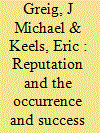

|
|
|
|
|
| Summary/Abstract |
In this article, we argue that because governments fear that accepting mediation and reaching agreements with opponents may signal weakness to other potential challengers, civil war governments tend to resist mediation as a means of demonstrating their resolve. Building on current theories of reputation in civil war, we argue that the threat of future challenges from other groups is likely to be particularly acute in states with multiple ethnic groups, especially states with high levels of ethnic exclusion. We therefore expect that civil wars in these states will be less likely to see mediation and to produce agreements when they do. By examining all instances of mediation in intrastate conflict from 1990 to 2008, we test this argument empirically and find that mediation is more likely to emerge in civil wars where there are a large number of ethnic groups, but is less likely to occur when many of those ethnic groups are excluded from the political process. Once mediation is underway, however, it is less likely to yield a negotiated settlement when there are a large number of ethnic groups, but more likely to end in a negotiated settlement when many of the ethnic groups are excluded from the political process.
|
|
|
|
|
|
|
|
|
|
|
|
|
|
|
|
|
|
|
|
|